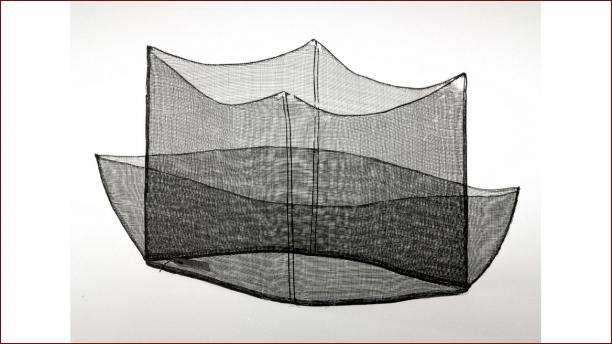Hoofdbedekking voor literaat

Paardenharen hoofddeksel dat gedragen werd door ambtenaren en literaten binnenshuis in combinatie met de officiële overjas (top'o or ch'angŭi). Dit type hoofddeksel komt voor in versies met een,...
Paardenharen hoofddeksel dat gedragen werd door ambtenaren en literaten binnenshuis in combinatie met de officiële overjas (top'o or ch'angŭi). Dit type hoofddeksel komt voor in versies met een, twee (zoals bij dit voorwerp) of drie lagen. In tegenstelling tot de hoofdband, die het praktische nut heeft de haren bijeen te houden, is de functie van dit soort hoofddeksels (Kor. kwan, 'kroon') om de officiële positie van de drager aan te geven (secretaris, leider van een confucianistische ceremonie enz.). Ze konden ook worden gedragen om praktische redenen in plaats van de volumineuze en fragiele zwarte hoed (kat). De paardenharen constructie van Koreaanse hoofdbanden, mutsen en de typische zwarte hoed werd al snel beroem; reeds in de vijftiende eeuw wordt melding gemaakt van export naar China. Soms kon ook menselijk haar gebruikt worden om bv. reparaties te doen. Traditionele Koreaanse hoofdbedekking kan grotendeels worden ingedeeld in twee groepen. De eerste groep, waar die voorwerp toe behoort, is die van mutsen en kappen (kŏn ‘doek/muts’ en kwan 'kroon’), bedoeld om de haarknot te verbergen en de social status van de drager aan te geven. Deze hoofddeksels worden direct op de huid gedragen en blijven ook binnenshuis op het hoofd. De tweede categorie is voornamelijk bedoeld voor gebruik buitenshuis en behelst hoeden met een rand (zoals Westerse hoeden) die worden aangeduid als ‘ip’ en ‘mo’. Hiervan is de typische zwarte hoed van de geleerde klasse het bekendst. Crown-style (kwan) cap made of horsehair, which was standard headdress for government officials and literati for indoor use, in combination with the official robe (top'o or ch'angŭi). This type of cap exists in variations with one, two or three 'layers' stacked onto one another. As opposed to headbands with the practical goal of keeping the hair in order, the function of these types of crowns/caps is to indicate that the wearer has an official position (secretary, head of a Confucian ceremony, etc.). They could also be worn for practical reasons in place of the more voluminous and fragile kat. The horsehair construction of Korean headbands, caps and the typical Korean black hat became famous early on; already in the fifteenth century mention is made of their export to China. In some cases human hair could be used for repairs. Traditional Korean headdress can largely be divided into two groups. The first group to which this object belongs is that of caps and hats (kŏn, or ‘cloth/cap,’ and kwan, or 'crown’), worn for the purposes of covering up the topknot and indicating the social status of the bearer. These are worn directly to the skin and can be worn inside the house. The second category is mainly for use outside of the house and consists of hats with a crown and brim (resembling the shape of Western hats), referred to as ‘ip’ and ‘mo.’ The most well-recognized hat in this category is the typical black kat worn by the educated classes.











Aanvullingen
Vul deze informatie aan of geef een reactie
Reactie